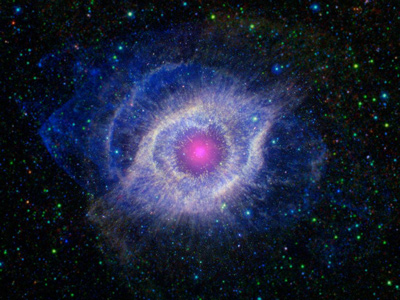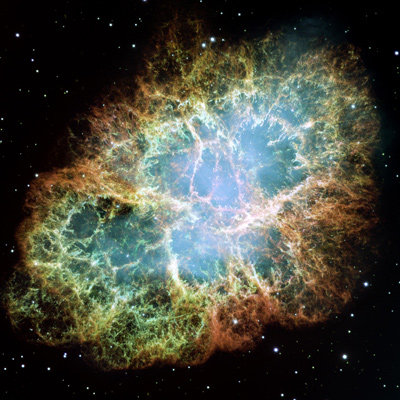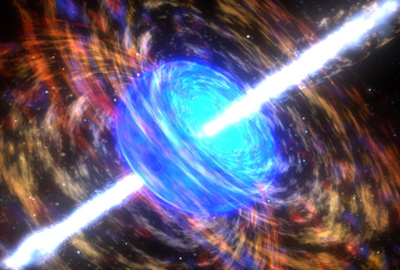Doomsday from Stellar Explosions
by Andrew Fraknoi and the Calendar in the Sky Team
Perhaps the most violent of all the predictions for how the world could end in 2012 is the idea that one or more stars might explode on December 21 and wipe out all life on Earth. A closer examination of how and when stars explode can put all our minds to rest.

The Helix Nebula is formed by a normal star at the end of its life. Its core has run out of fuel and the outer layers of the star are slowly and calmly being thrown out into space to create this beautiful site. Our Sun will also die in this fashion about five billion years from now. Image credit: NASA/JPL-Caltech
The Death of Normal Stars
From a cosmic perspective, most stars – including the Sun – will experience a relatively peaceful death. Toward the end of their lives, with no fresh source of energy to support them, the cores of smaller (lower-mass) stars will collapse until they become not much bigger than a planet. The stars slowly shed their outer layers during this process. Eventually all that will be left behind are tiny and white hot cores, that astronomers call “white dwarfs.” White dwarfs simply cool off for billions and billions of years.
The Death of Massive Stars
When stars contain a lot more material than the Sun, they have a more violent death in store for them. When they reach the end of their lives, their cores become unstable, and collapse into extremely compact objects called neutron stars or possibly even into black holes. The vast majority of the star’s material explodes into space. Astronomers call such an exploding star a supernova.
A supernova releases a tremendous amount of energy as it explodes. For a brief time, the dying star can become as bright as the entire galaxy of billions of stars in which it lives. Ancient records contain stories and pictures of such supernovae becoming so bright in our skies that they could be seen in the daytime. The last visible supernova in our own Milky Way Galaxy was seen in the year 1604.

The Crab Nebula: the result of a supernova noted by Earth-bound chroniclers in 1054 A.D. The Crab Nebula spans more than 10 light-years. In the nebula's very center lies a neutron star more massive than the Sun but with only the size of a small town. Image Credit: NASA, ESA, J. Hester, A. Loll (ASU)
Another Kind of Star Explosion
The core collapse of a massive star is not the only way to make a powerful stellar explosion. More than half of all the stars in the sky do not live alone – they go through their lives entwined in the gravity embrace of one or more companion stars. Let’s imagine a system of two stars, orbiting each other quite closely, but each going through the stages of its life at its own pace. One member of the pair dies first to become a white dwarf. The other star eventually goes through a stage in its life where it swells up considerably – for a time becoming much larger than it used to be.
Then material from this “giant star” can spill on its white dwarf partner. The strong gravity of the white dwarf can pull a great deal of material toward it and – in a sense – overload its ability to remain stable. The white dwarf star can re-ignite with nuclear reactions and blow itself to smithereens.
Danger and Distance
If either kind of supernova happens somewhere in our Galaxy, how dangerous would it be to the residents of planet Earth? That depends on how far away the explosion occurs. Supernovae are guaranteed to be deadly for life on any planets orbiting the exploding star and in any star systems that are nearby. Somewhat further away, the powerful radiation from the blast (gamma rays and X-rays) could still be dangerous by breaking down the ozone layer that protects a planet like ours from the ultraviolet rays of its sun. But, as you get farther and farther away from a supernova the danger decreases.
How close would a supernova have to be to be considered a serious danger to life on Earth? Current estimates indicate that the exploding star would have to be somewhere between 25 and 50 light-years from Earth to be a serious danger. (A light-year, the distance light travels in one year, is equal to about 6 trillion miles, or 10 trillion kilometers. The nearest star is about 4 light-years away.)
Explosions farther away than that range of distances may be disturbing, but are not likely to be deadly. The more distant the explosion, the less there is to worry about. Armed with this information, astronomers have naturally asked: “Are there any massive stars, or systems containing a white dwarf and a close neighbor, that are within our danger zone?” And the answer, we are happy to report, is a resounding “No!”
This is not just because we are lucky, but also because the kinds of stars that explode are quite rare. Most stars are low-mass stars, the majority of them lower in mass than our Sun (and our Sun will not explode). So high-mass stars are very much the exception and the nearest ones are much farther away than the distances where we have to worry. In the same way, close pairs of stars harboring both a white dwarf and an expanding giant star are also quite rare, and thus separated by significant distances.

A computer animation of a gamma-ray burst generated by the death of a star. The core of the star has collapsed, without the star's outer part “knowing.” A black hole forms inside, surrounded by a disk of accreting matter, and, within a few seconds, launches a jet of matter away from the black hole that ultimately makes the gamma-ray burst. Image Credit: NASA / SkyWorks Digita
Gamma Ray Bursts
On very rare occasions, the deaths of stars can lead to even more energetic events than a supernova. Such events release more energy in a few seconds than the Sun will give off in its entire lifetime, and can be detected all the way across the Universe when our instruments in space pick up what is called a gamma ray burst. Mirroring the story of supernovae, there are two kinds of systems that can lead to a gamma ray burst. The first comes when two neutron stars (the corpses of high mass stars and remnants of supernovas) collide and produce a devastating release of energy. The other type of gamma ray burst happens when the core of a star with really tremendous mass (a superstar, you might say) collapses and becomes a mind-boggling object called a black hole. While black holes themselves don’t give off energy, their birth can be accompanied by an explosion sometimes called a hypernova. Both types of explosions can generate two sudden beams of enormous energy. If one of the beams happens to point right at the Earth, we detect a gamma ray burst.
Both of these events are so rare, that hundreds of millions of years typically pass between gamma ray bursts in any given galaxy. For a burst like this to be dangerous to us, the event would have to happen not only inside our Milky Way Galaxy, but in our section of it. And, if it is a beamed burst (like most are)the beam would have to point exactly in our direction. The chances of this are so small that no scientists spend any time worrying about being a gamma ray burst victim. And neither should you.
2676